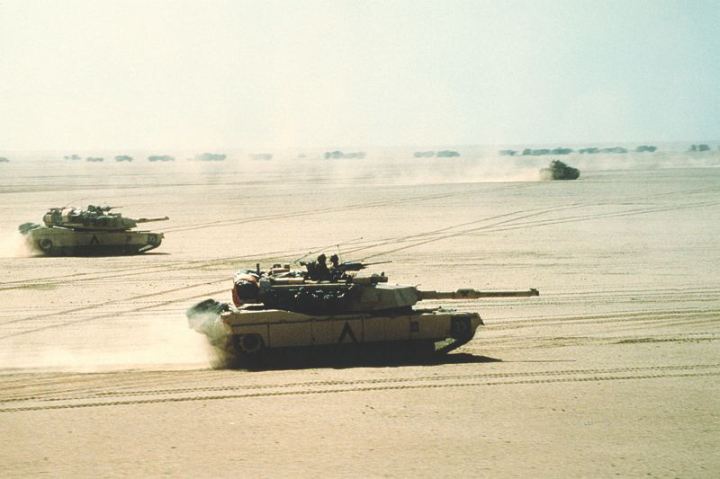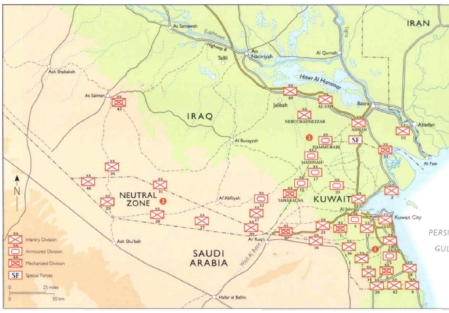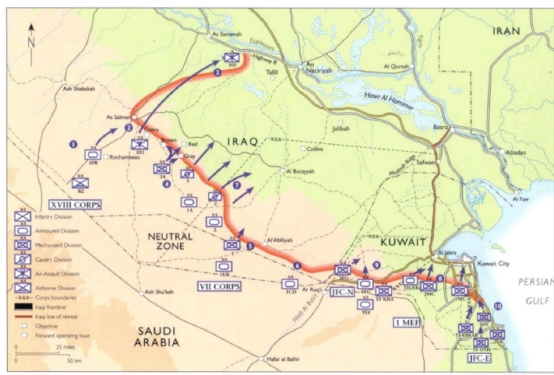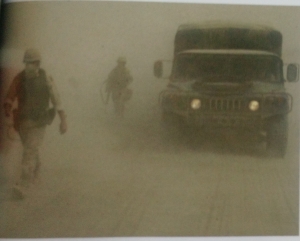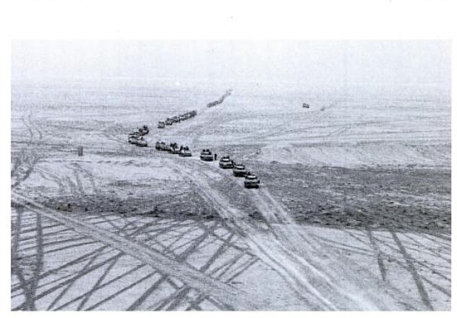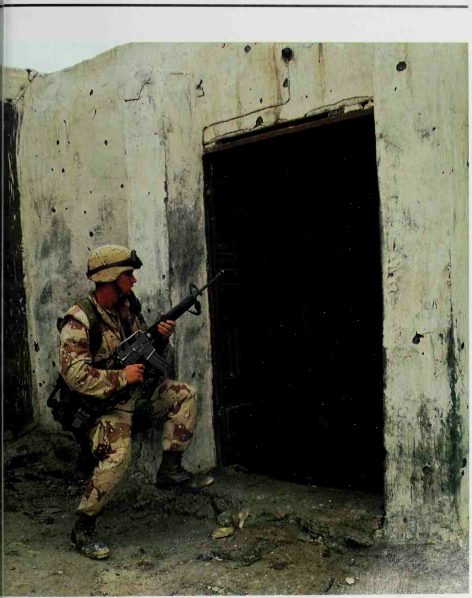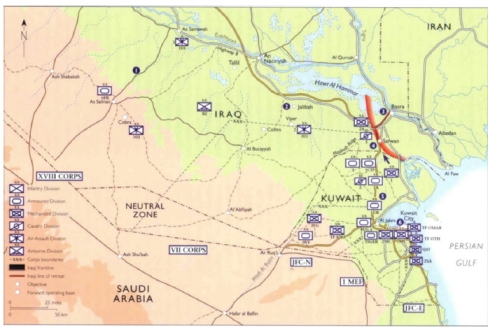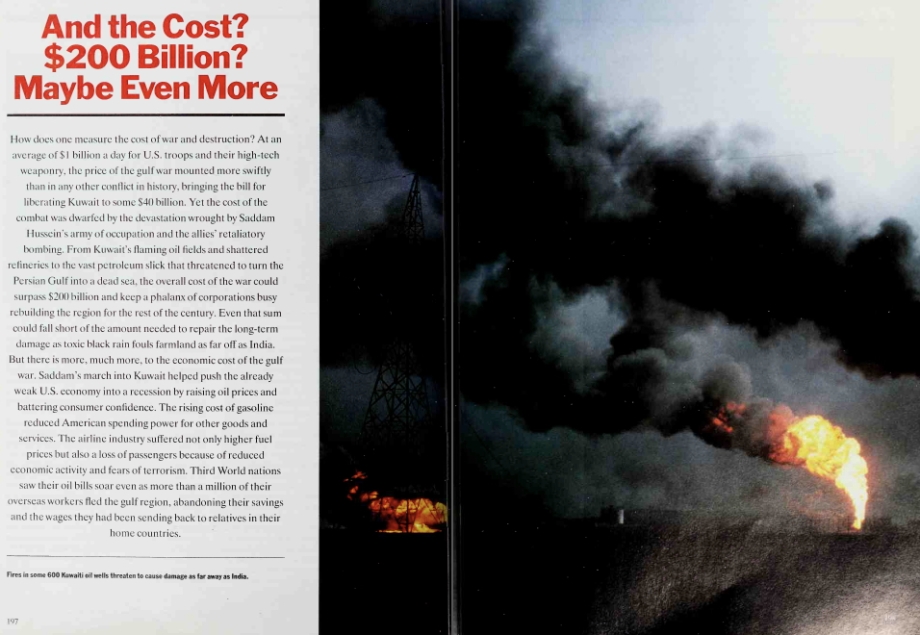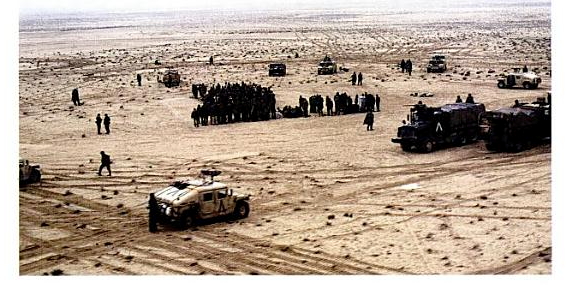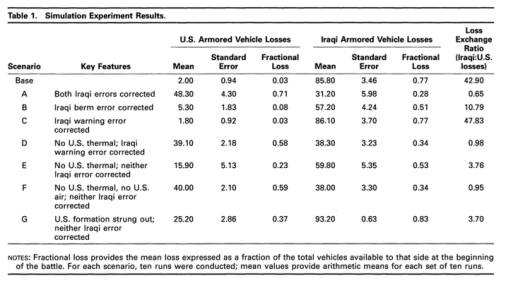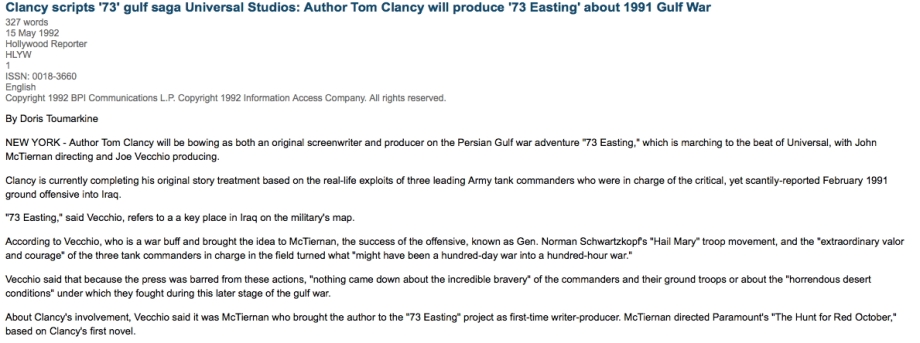Tank tactics at the Battle of 73rd Easting: February 26, 1991.
Introduction
Two days into the coalition ground war in Kuwait and Iraq, Phase IV of Operation Desert Storm,[i] the armour of Third Army’s VII Corps attacked Iraq’s Republican Guard and other armour brigades in a series of battles, forty-one hours in duration, that commenced with the Battle at 73 Easting.[ii] After crossing into Iraq on 24 February, the Coalition’s armoured and airborne forces raced across the desert to locate and engage Iraq’s Republican Guard, known to be holding positions near the border with Kuwait. On February 26th, VII Corps’ mechanized units encountered the Republican Guard and three of its own mechanized divisions, deployed to protect the flank of Iraq’s withdrawal corridor through Basra. Keeping this route open was crucial, as was closing it to prevent Iraq’s Army from escaping.[iii]
US 3rd Armor crosses the Iraqi desert.
The actions occurred on the afternoon, and evening of 26th February, 1991, around the 73rd easting grid coordinate, near Objective Norfolk west of the Kuwait-Iraq border. When President Bush’s ultimatum of February 23rd expired, the Coalition launched its massive offensive, with the expectation of a confrontation with Iraq’s Republican Guard shortly to follow. The ground phase of the campaign commenced on the 24th, with the advance of VII (armour) and XVIII (airborne) Corps through the desert, combined with Joint Forces Command-North & East, and Marine Forces Central Command, operations to secure Kuwait and Kuwait City.[iv]
Although the battle that started at 73 Easting continued on the 27th and engulfed components from the Republican Guard’s Medina, Adnan and Hammurabi Divisions, and the remainder of the 12th Armored Division, this post examines primarily the tactical and operational circumstances of the Battle at 73 Easting between VII Corps and the Tawakalna Division, on 26th February.[v]
The battle has generated significant interest amongst scholars and soldiers alike as a case study concerning the influence of technology and training on operations and tactics, including the role of air power and close air support prior to land operations; the significance of weather and environmental friction, and the importance of battlefield intelligence and robust command and control to prevent blue-on-blue incidents. The one-sided nature of the engagement has unsettled analysts and military historians as to the deceptive role played by any one of these elements.[vi] The Battle of 73 Easting was the first salvo in the last major tank battle of the Cold War, indeed, what turned out to be the largest tank battle since the Battle of Kursk in July 1943.[vii] This post looks at the tactical movements during the opening phase of battle through a narrative, and the conclusion addresses the historiographical question of the tactical lessons of the battle.
Disposition of Iraq’s Army at the start of the ground war, 24 February 1991.[viii]
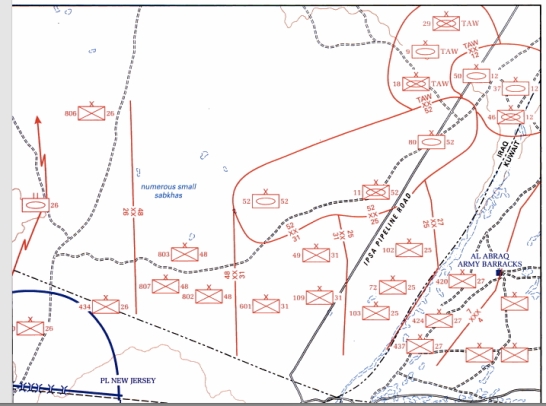
Disposition of forces.
Iraq deployed 26 of its infantry divisions along its Saddam Line, and supported these with 9 mechanized divisions, with the 8 Republican Guard divisions acting as a mobile reserve. The Republican Guard had been formed in the 1970s and expanded during the Iran-Iraq war of 1980-8 with the recruitment of college educated soldiers. By 1990 the Republican Guard comprised 3 armoured divisions and 5 infantry divisions. The Tawakalna Division, the main antagonist of VII Corps on February 26th, was composed of 220 T-72s and 278 Infantry Fighting Vehicles (IFVs), and was commanded by Major General Salah Aboud Mahmoud. The division had been moved to the west of the Iraq Petroleum Saudi Arabia (IPSA) pipeline road, roughly 80 miles from Kuwait City.[ix]
The Coalition’s Third Army, to which VII Corps was attached, published its programme of operations on 5 January: Operation Plan 001 which ordered VII Corps to, “Conduct main attack in zone to penetrate Iraqi defenses and destroy RGFC [Republican Guard Forces Command] … in zone.”[x] XVIII Airborne Corps would cover the 260 kilometers to the Euphrates, and VII Corps, with the heaviest concentration of armour, would move on Al Basrah where Iraq’s Republican Guard was deployed.[xi] A US Army heavy brigade was a formidable force, containing up to 3 battalions of M1A1 tanks (116 total) and another battalion of 54 Bradleys plus scout, mortar, air-defence and support vehicles. Formed into a 22,000 soldier division, the unit covered a frontage of 25-45 kilometers, with a depth of 80-150 kilometers.[xii]
Operation Desert Storm: The 100 hour ground campaign.[xiii]
3rd Armored Division tanks
Battle Narrative
Initial Coalition movements, G-day, 24 February.[xiv]
At 2:30 pm on 24 February, VII Corps started its drive to the Euphrates. Small groups of the enemy were encountered and destroyed, and prisoners were captured from overrun outposts. Almost all but 200 members of Iraq’s 110th Infantry Brigade surrendered when their position was overrun by US armour.[xv] Unfortunate friendly fire incidents raised concern amongst Army leadership. An entire division of artillery was assembled from five brigades of M109A2 155mm self-propelled howitzers and rocket launchers in preparation for supporting the advance the following day.[xvi] Meanwhile, the night of the 24th, General Salah Aboud Mahmoud issued orders to redeploy two brigades from Iraq’s 12th Armoured Division to support the Tawakalna Division.[xvii] By the end of the first day, the Coalition offensive had secured 13,000 prisoners at the cost of 8 combat dead and 27 WIA.[xviii]
G+1, 25 February.[xix]
The drive was continued on 25 February, as the VII Corps forward elements encountered scouts from the Republican Guard divisions, destroying a number of Armoured Fighting Vehicles (AFVs) in the process. General Schwarzkopf (CENTCOM) urged Lt. General John Yeosock (Third Army), to put pressure on VII Corps commander, Lt. General Frederick M. Franks, to accelerate his advance.[xx] Delays were caused when prisoners were taken or the tanks had to stop to refuel. Otherwise, the T-55 tanks and groups of infantry deployed to screen the heavier elements positioned closer to Kuwait, were brushed aside without much resistance. American helicopter gunships engaged T-55 tanks from Iraq’s 26th Infantry Division. The deadliest Scud attack of the war, in terms of military casualties, occurred on 25 February when an IRBM fired at Dhahran, Saudi Arabia, hit an American barracks and killed 28 soldiers, wounding 100 more.[xxi]
It was now the morning of February 26th and the leading elements of the 2nd Armored Cavalry Regiment (ACR) were tired, having slept, still in their Nuclear Biological Chemical (NBC) suits, for only a few hours in three days, and the days before had been spent rehearsing under an ever increasing tempo of operations. Worse, the tank formations were facing adverse weather conditions, including oil-rain, which was limiting strategic reconnaissance.[xxii] The enemy had so far put up only sporadic resistance from isolated vehicles and strongpoints, but was certain to have massed large formations of tanks and artillery nearby the Basra corridor. In fact, the Tawakalna commander was now aware that he faced a large Coalition force, including American armour, and had prepared reconnaissance positions (no more than 20 tanks and 40 IFVs) to provide information on the American advance.[xxiii] The division’s three heavy brigades, the 18th, 29th, and 9th were positioned to cover the IPSA road. The Tawakalna line also included the 37th Armoured Brigade, and the remains of the 9th and 50th brigades. [xxiv]
G+2, 26 February, defeating the Republican Guard, Kuwait City is secured.[xxv]
Battle of 73 Easting, US armour attacks the Republican Guard Forces Command (RGFC).[xxvi]
At 8:30 am, Ghost Troop, 2d ACR scouts, engaged and destroyed an Iraqi troop carrier from the Tawakalna Division.[xxvii] At 10 am, Eagle Troop was maneuvering into position through the fog.[xxviii] Lt. Petschek, commanding Eagle Troop’s scout platoon of six Bradleys and 30 soldiers, deployed forward, with Lt. Timothy Gauthier’s third platoon scouts in close contact with Fox Troop to the north. Lt. Michael Hamilton and Jeffrey DeStefano had two tank platoons positioned behind the scouts to support them. At this point, Staff Sergeant Patterson, Eagle Troop, reported contact with three enemy MTLBs (Soviet Multi-Purpose Tracked Vehicles).
Ghost Troop Bradleys quickly destroyed two more of the enemy APCs (Armoured Personnel Carriers), scouting elements of the Tawakalna Division. Captain H. R. McMaster, in his command M1A1, engaged and destroyed the third MTLB before it could escape, gunner Staff Sergeant Craig Koch hitting the APC with a HEAT round at over 2 kms distance.[xxix] By 10 am the rain had cleared, but only to produce a thick fog and low clouds. Eagle Troop was now ordered to move south of Ghost Troop, and tie in with Iron Troop of 3rd Squadron. 2nd Squadron’s operations officer, Major Douglas MacGregor, assured McMaster that Eagle Troop would be in the lead when, “contact with the Republican Guard was imminent”. At 12 pm the Troop was leading the squadron’s movements towards the 60 easting.[xxx] The Troop was ordered to stop again at 1 pm, and prepare defensive positions, during which they again refueled their vehicles.
Sandstorms encountered in the Second Gulf War: 5th Marines on 26 March 2003, and a V Corps Humvee.[xxxi]
The Left Flank
A sandstorm now obscured visibility as the American forces approached the Iraqi positions.[xxxii] The Troops pressed forward, and at 3 pm, encountered and destroyed 3 enemy tanks.[xxxiii] Between 3:15 and 3:25, McMaster’s Eagle Troop was ordered to push to the 70th Easting, and fix the location of the Republican Guard forces.[xxxiv] Within 15 minutes, Eagle Troop came under fire from Iraqi artillery and infantry occupying buildings at the 69th Easting. These were the forward elements of the 18th Mechanized Brigade. Enemy air-burst artillery landed amidst Lt. Petschek’s scout platoon, causing them to close their hatches.[xxxv] The M1s (Abrams tanks), and M3s (Bradley cavalry vehicles) returned fire and pushed forward, despite incoming Iraqi artillery.[xxxvi] At 3:56 Staff Sergeant Jon McReynolds (3rd platoon) passed an Iraqi bunker whose four occupants quickly surrendered when McReynolds and Sergeant Wallace, and Private First Class Robert Sanchez, dismounted and confronted them.[xxxvii] At 4:07 Eagle Troop found the Republican Guard main force, in the form of dug-in T-72 tanks. Ghost Troop’s 1st Lt. Keith Garwick, commanding a 3rd Squadron Bradley platoon, was engaged in an intense firefight at 4:42 pm, in which a T-72 company counter-attacked their position, and by 5 pm the Bradley’s had destroyed 9 APCs and were engaging enemy infantry.[xxxviii] Also at 5 pm the Iraqis opened a counter-barrage on Ghost Troop, with rounds landing near Bradley G-16 obscuring the sight of 23-year-old gunner Sergeant Nels A. Moller, and within seconds a tank shell hit the Bradley’s turret and destroyed it, killing Moller, while the remaining crewmen escaped to nearby Bradley G-15.[xxxix] PFC Jeff Pike, 21-years-old and the driver of Captain Sartiano’s command M1A1, believed their gunner now destroyed the responsible enemy T-55, although it was impossible to confirm.[xl] It was now just after 6 pm, and the sandstorm reappeared with intensity: soon visibility was limited to a mere 50 yards.[xli] The Republican Guard attacked in waves of tanks, and Ghost Troop was unsupported by coalition air forces, although it was backed by powerful regimental artillery.
American Mechanized column.
Meanwhile, north of 2d ACR, at 4 pm, Captain Gerald Davie of Alpha Troop, 4/7 Cavalry, 3rd Armd Division, was moving as part of a compact, 27 kilometer wide formation of two brigades, supported by divisional artillery and followed by the 4th Battalion of the 34th Armored Regiment.[xlii] When it arrived at the 73rd Easting, Alpha Troop’s 3rd platoon (6 Bradleys) reported Iraqi BMPs (Soviet IFVs) and infantry in front of them, and 2nd platoon, with another 7 Bradleys deployed and opened fire with 25mm cannon. Captain Davie, in 2nd platoon, “could see tracer rounds streaking across the battlefield in both directions. He could see small explosions as the 25-mm rounds impacted on the BMPs. Through his thermal sights, Davie could see more vehicles in the distance.”[xliii] Although they could only see a few vehicles abreast of him, due to the storm, the platoons continued to advance, and although Captain Davie did not realize it, was now moving into the sights of T-72 tanks: obscured by the weather and only 300 or 600 meters away. Alpha Troop encountered enemy infantry at 75 meters and soon Iraqi artillery began hitting their position. Within moments Alpha Troop was in a major engagement with Republican Guard tanks. Bradley A-24 was destroyed and Staff Sergeant Kenneth Gentry, despite the efforts of medics deployed by A-25 and A-26, died of his wounds. The Bradleys began to engage the enemy T-72s with TOW missiles. A-33 was hit by heavy machine gun fire, wounding its commander.
Destroyed Tawakalna Division T-72.[xliv]
With 1st platoon acting as a diversion, 2nd and 3rd platoons withdrew under fire. Davies was also under friendly-fire from elements of the 2nd ACR and 4th battalion, 34th Regiment. As A-36 withdrew, it was hit by small arms gunfire, knocking out the vehicle’s transmission. As A-36’s occupants were about to be picked up by A-31, an M1A1 fired at A-36, showering the Bradley’s driver with shrapnel. The wounded man was retrieved and A-31 moved westward, when it was struck twice by armour-penetrating sabot rounds, neither wounding any of the occupants. However, Sergeant Edwin Kutz, gunner of A-22, was killed when the Bradley was hit by a tank round. Alpha Troop accelerated its withdrawal, deploying a smokescreen and moving west at thirty miles per hour.[xlv] Alpha Troop had two KIA and 12 WIA with three Bradleys out of commission and another four with various degrees of damage.
Meanwhile, to the south of Alpha and Ghost Troops, the tank platoons of Eagle Troop advanced, crossing a minefield, and engaging the enemy. McMaster’s command tank destroyed a T-72 at 4:18, and by 4:22 a total of 9 Iraqi T-72s had been destroyed, and the advance continued.[xlvi] Within forty minutes of joining battle, Eagle Troop had destroyed 37 T-72s and 32 other vehicles. [xlvii]With many Iraqi tanks destroyed, McMaster pressed forward until he reached the 73rd Easting, radioing when asked why he was passing the 70th Easting: “I can’t stop. We’re still in contact, Tell them I’m sorry.” At 4:40, with as many as 17 more T-72s in sight, but out of range, Eagle Troop halted its advance.[xlviii]
Iron Troop, to the south of Eagle Troop, attacked the fortified positions Eagle Troop had by-passed, and destroyed a number of T-72s and BMPs, while support from Apache helicopters neutralized the enemy’s artillery to a depth of 12 kilometers beyond the 73rd Easting.[xlix] At 4 pm, 3d Brigade of 1st Armored Division, and 2nd Brigade, 3rd Armored Division were engaged in an air and artillery battle with Iraqi forces. The 3d Brigade called in A-10 Thunderbolt II attacks, and the 2nd Brigade engaged the enemy in-front of them with artillery. Progress was slow, and despite the M1A1 thermal sights, visibility was limited to less than two kilometers by the sand and rain.[l]
1st Cavalry trooper prepares to enter an abandoned Iraqi bunker.[li]
North of Alpha Troop, Lt. Colonel John Brown’s 3/5 Cavalry was encountering Iraqi bunkers and prepared positions, about 5:05 pm.[lii] Captain Tony Turner’s Charlie Company, of 3/5 Cavalry, encountered an Iraqi bunker complex and dug-in T-72 tanks and BMPs. Within seconds, First Lieutenant Donald Murray’s Bradley was damaged in the track-wheels by T-72 fire.[liii] Captain Turner ordered his M1A1s into position and soon First Lieutenant Marty Leners, from tank Charlie 1-1 was engaged in a duel with a T-72, destroying the enemy tank after missing his first shot.[liv] With artillery support, the entire 1st Brigade developed its advance, with Charlie company, 3/5 Cavalry, leading the assault on the bunker complex.
Lt. Col. Tony Isaacs and 1st Squadron, 2d ACR, had meanwhile encountered elements of the 50th Armored Brigade and engaged several battalions as it pressed towards the 70 Easting. At 5 pm, the 1st Squadron was positioned to attack the 37th Armored Brigade. The sun was setting at 5:50 pm.[lv]
The Centre
North of 1st Brigade, 2d Brigade’s Colonel Higgins, 3rd Armored Division, also attacked at 5 pm. A Task Force comprised of a reinforced battalion was drawn from 4/8 Cavalry to lead the centre of the brigade’s attack, and was supported by divisional artillery.[lvi] 4/8 Cavalry engaged the enemy at 5:22, and was fighting 4 enemy BMPs at 5:27. The 3rd Armored Division had encountered three battalions of the 29th Mechanized Brigade, three armoured and one mechanized battalion from the 9th Armored Brigade, and one battalion of the 46th Mechanized Brigade plus a T-62 tank battalion, for a combined total of 160 Iraqi tanks and 117 BMPs.[lvii]
Captain Ernest Szabo’s Charlie Tank Company attacked into a flurry of enemy RPGs and artillery rounds. Ordered back by Lt. Col. Beaufort Hallman, Szabo, in tank Charlie 66, was delayed when the tank threw a track. Captain Szabo dismounted and ran through the artillery storm to eventually find Charlie 65 with a working radio and Charlie Company pulled back at 5:55. Colonel Higgens asked for artillery and Apache support and was given it, providing breathing space for the battle group to reform under artillery and air cover, with plans to continue the attack at 10 pm. General Funk, at 3rd Armored Division headquarters, prepared am artillery barrage including 5 battalions of artillery and an attack helicopter battalion.[lviii] When the attack came it lasted for 4 more hours, ending at 2 am on February 27th, with the 2nd Brigade having fought through much of the enemy’s 29th Brigade, despite the enemy’s determined counter-attacks.
Meanwhile, at 6 pm 4/7 Cavalry Squadron encountered dug-in Iraqi tanks. Unable to press the advance without heavy armour, the Bradley squadron pulled back, suffering damage to 9 of its 13 M3 Bradleys, plus another 2 damaged by friendly fire. 4/7 suffered 2 KIA and 12 WIA during this engagement. In effect, Iraq’s 9th Armoured Brigade had halted the advance of the US 1st Brigade, 3rd Armored Division.[lix]
The Right Flank
The 1st Armored Division moved across the Phase Line (PL) Tangerine at 6 pm, three brigades abreast. 1/1 Cavalry, a detachment alongside 3rd Brigade, 1st Armored Division, encountered a large number of enemy tanks, 52 in all, and called down artillery against them, destroying 30 successfully.[lx] At 6:30, Colonel Zanini, commanding 3rd Brigade, 1st Armored Division (the most heavily armoured formation in the US Army, known as the “Bulldog” Brigade), delivered orders to Lt. Col. Ed Dyer commanding 1/37 “Dragon” Armor Battalion, who then issued attack orders to the battalion’s company commanders at 6:45: “Buster, Cobra, Dauntless, Gator – we have just gotten word that one brigade of the Tawakalna Division is a few kilometers to our front. The enemy unit consists of more than a hundred armored vehicles…”, and concluded with orders to form, “DRAGON’S ROAR [formation] on my command!”[lxi] The 1/37 battalion’s formation included 45 M1A1 tanks, supported by attack helicopters and Bradleys.[lxii]
155mm DIPCM howitzers from 3/1 Field Artillery began hammering the enemy positions in front of 3rd Brigade at 7pm.[lxiii] Although the artillery missed its target, it scattered the Iraqi forces nevertheless, who believed they were under air attack.
This was the situation at 8 pm: Ed Dyer’s TF 1/37 Armor Battalion, and TF 7/6 supported by TF 3/35 in reserve, moved on the 68th Easting at PL Libya. Task Force 1/37 Abrams tanks moved into position, using their patent battalion formation in phalanx form, in which the M1A1s presented a single front, each MBT (Main Battle Tank) fifty meters apart, the entire line 2 kms long (2d ACR, for its part, had its own formations, such as the Troop Diamond formation, with four Troops forming the diamond’s points).[lxiv] Delta Company, 1/37 now approached the positions occupied by Iraqi infantry, who, once the American artillery lifted, assaulted Delta’s position in rushes. They were quickly reduced by heavy machine gun, and more targets were encountered on the horizon. The brigade opened up with TOW missiles and cannon fire, and at 8:30 pm Colonel Zanini ordered 1/37 to advance into the Iraqi positions, with 7/6 providing over-watch. As the divisional artillery MLRS (Multiple Launch Rocket Systems) went into action on targets in the rear of the Republican Guard positions, Captain Dana Pittard, of Delta Company, led the advance of Bravo and Charlie companies, storming a ridge and continuing to engage Iraqi vehicles.[lxv]
Iraqi trenches.
As the battalion moved down the ridge, it encountered dug-in Iraqi tanks. At extreme ranges, the longest of 3.7 kms, and an average between 2 and 3 kms, the Americans engaged the Iraqi tanks, devastating them with M-829AI Armor Piercing Sabot depleted uranium munitions. Apache helicopters covered 1/37s advance.[lxvi] M1A1, Delta-24, was hit and destroyed- the crew injured, but escaped- and the battle became close-in around burning vehicles and bunkers. One of Bravo company’s tanks was hit in the rear and disabled, the crew escaped unharmed, tank burning. C-22 was hit shortly afterwards, and also disabled without major injuries. The C-Company commander’s tank was hit, for a total of four damaged tanks with 16 general uninjured crewmen escaping.[lxvii] The battalion was under fire from concealed Iraqi positions strewn amongst the burning hulks of their tanks and bunkers. 7/6 Infantry now advanced and secured prisoners, and by 11 pm the battlefield was reported cleared, with over 100 prisoners taken.[lxviii]
At 8:30 pm, HQ-26, a Bradley AFV from 4/32 scouts, was engaged by a T-72 and enemy infantry. Private First Class Frank Brandish was able to knock out the T-72s road-wheels with a TOW missile, however, in return, the T-72 killed Staff Sergeant Christopher Stevens in the Bradley’s turret. Nearby, HQ-21 joined the skirmish, destroying the T-72 with another TOW missile. As PFC Bradish and PFC Adrian Stokes escaped the wreck of HQ-26, they were fired at with heavy machine gun. Peppered by gunshots and their own ammunition as it cooked-off inside the burning AFV, Stokes went down, but was retrieved by the wounded Bradish, although Stokes soon succumbed to his wounds. Bradish continued to retrieve supplies and equipment from the Bradley, and was able to recover gunner Sergeant Donald Goodwin, who had been blown fifty meters from the destroyed Bradley, and was suffering from a chest-wound.[lxix] Lt. James Baker, in HQ-21, called in mortar fire on the Iraqi infantry engaging HQ-26 and then moved to recover survivors. Twenty minutes later, rapidly arrived medical tracks were administering to the wounded Bradish and Goodwin.
The battle continued until about 10 pm, when General Funk decided to suspend the attack until the following day, to prevent further friendly fire incidents.[lxx] Specialist Chris Harvey, in an APC of the hard-pressed Ghost Troop, recalled seeing 360 degrees of carnage from his position: “All I saw were things burning,” he recalled.[lxxi] Air and artillery attacks continued throughout the night.
M3 destroyed by friendly fire.
General Griffith, with 3d Brigade, had engaged the northernmost elements of the Tawakalna Division, and he soon dispatched 1/1 Cavalry to search for the Medina Division to the north. As the sun was setting, the cavalry troops were 50 kms ahead of the rest of the division, when they encountered enemy T-72s and BMPs. It was now 10 pm, and 2nd Brigade, 1st Armored Division, had also started to encounter the forward positions of the Medina Division, although they had been abandoned as the division contracted into its close security zone.
American troops secure an abandoned Iraqi Army radio station along the Euphrates river valley.[lxxii]
As this was happening, General Funk received intelligence from VII Corps command, informing him that a JSTARS aircraft had spotted a battalion sized detachment from the Tawakalna Division preparing to counter-attack between 1st and 3rd Armored Divisions. Colonel Burke, General Funk’s Aviation Brigade Commander was now alerted, and he rapidly deployed 24 Apache gunships, which struggled through the worsening weather and storms and, identified the enemy tank formation at 11 pm. Descending on their targets the Apaches destroyed 8 T-72s and 19 BMPs in 3 minutes, while more Apaches from the 1st Infantry Division attacked far behind the enemy’s lines at the 90th Easting.[lxxiii] Throughout the night 3rd Armored’s 4/18 Infantry was involved in intense combat with Iraqi infantry counter-attacks. A VULCAN antiaircraft system was employed to decimate the enemy’s infantry attacks.
20mm VULCAN cannon mounted on M113 APC, destroying an Iraq Army truck.[lxxiv]
The “Big Red One”, 1st Infantry Division, now pressed the attack, providing relief to the 2nd ACR. The 1st Division included 334 M1A1s, 224 M2A2 Bradleys, and 3 battalions of attached engineers.[lxxv] It was an apocalyptic scene for the soldiers of 1st “Devil” Brigade who encountered a situation in which they pressed, “… through the darkness toward what looked like Armageddon. The eastern horizon was ablaze with green and red tracers and MLRS rocket trails, punctuated by bursts of light from tank cannon fire and artillery explosions. Fires raged from destroyed Iraqi vehicles all along the horizon.”[lxxvi]
Movements of the 1st Infantry Division.[lxxvii]
2nd Battalion, “The Dreadnoughts”, 34th Armored Regiment, now pressed in to relieve Ghost and Eagle Troops, although the plan at this point was vague and intelligence on the enemy incomplete. Colonel Maggart of the 1st Brigade moved forward to the 2/34 battalion’s position and ordered the 5/16 battalion to screen 3 kilometers to his rear.[lxxviii] In the process of this leap-frog attack. 1/34’s “Centurion’s” battalion encountered BMPs and T-55 tanks. Captain James A. Bell saw a regimental scout Bradley go up in flames, the crew, with 4 injuries, running from the flaming wreck. As M1A1 tanks moved up to engage the T-55s, another Bradley was hit, killing the gunner and wounding the leader of the scout platoon.[lxxix] The 1/34 pressed its attack, supported by 1st Brigade and 3rd Brigade, and 2/34 battalion had overrun the Republican Guard positions and were indeed arriving at the Kuwait border (PL Milford) after 1:35 am.
Meanwhile, at 1 am, B Troop of 1/1 Cavalry came under artillery fire as they began to encounter the Adnan Division, and suffered 23 soldiers wounded and 5 vehicles destroyed. Apaches were dispatched to counter the enemy’s artillery.[lxxx] In the ensuing Apache attack, 38 T-72 tanks were destroyed, along with 14 BMPs and 70 trucks.
3rd Armored Division was now beginning to approach the Iraqi Al Faw Division, and on the orders of General Franks, Colonel McCauley and the 18 Apache gunships under his command, were ordered to attack Objective Minden, logistical stores and division command for the Al Faw Division. McCauley assigned target areas and the Apaches engaged until they ran up against the 20th grid line, which demarcated USAF area of operations, in which F-111s were active.[lxxxi]
Victory: the situation by the evening of 27 February, G+3.[lxxxii]
Fighting continued into the morning, and at 7 am, orders were issued to cross into Kuwait. After 7:30 am, 4/32 battalion encountered a stray Iraqi tank battalion moving northward and destroyed it, including 15 tanks and 25 other vehicles.[lxxxiii] After halting to reform, the advanced continued, and at 12 pm, the 2nd Brigade of the 1st Armored Division, attacked The 2nd Brigade of the Medina Republican Guard Division, in what is known as the Battle of Medina Ridge, “the largest single engagement of the war”, where the Iraqi 2nd Brigade was totally destroyed for no Coalition fatalities.[lxxxiv] Following reports from Schwarzkopf that of the 4,700 tanks deployed by Iraq, nearly 3,700 had been destroyed, President Bush suspended operations at 9 pm, Wednesday, Washington time, confirmed by General Colin Powell, for 8 am the following day in Kuwait.[lxxxv] This was in part influenced by media reports coming from Iraq regarding the carnage on Highway 6, soon named the “Highway of Death”.[lxxxvi]
Conclusion
At the conclusion of the forty-hours of combat, VII Corps had destroyed 1,350 tanks, 1,224 armored troop carriers, 285 artillery pieces, 105 air defence systems, and 1,229 trucks, while having sustained only 36 armored vehicles losses to enemy fire: 47 KIA with 192 wounded.[lxxxvii] These figures are significant: before ground operations commenced Third Army Personnel Command predicted that VII Corps would sustain 20,000 casualties by G+4.[lxxxviii]
The Coalition suffered 148 American, 47 British, 2 French, and 14 Egyptian fatalities, and 357 WIA, in the ground campaign.[lxxxix] 60,000 Iraqis had been killed and 2,500 tanks, 2,000 IFVs, and 2,000 guns destroyed.[xc] As historian Stephen Biddle put it, the salient fact of the war was the Coalition’s miniscule casualty rate: “795,000 Coalition troops destroyed a defending Iraqi army of hundreds of thousands for the loss of only 240 attackers.”[xci] Over 80,000 of Iraq’s soldiers had surrendered or been captured with another 100,000 retreating back to Iraq.[xcii]
Oil wells on fire: the First Gulf War as an ecological catastrophe.[xciii] The average cost of the war was 1 billion US dollars a day, with total cost estimated at over $200 billion, accounted in 1991 dollars.[xciv]
The heavily engaged 2d ACR elements, in particular, Ghost, Eagle and Iron Troops, destroyed an entire Republican Guard Brigade; 50 T-72 and T-62 tanks, over 35 other AFVs, (113 AFVs in total), and at least 45 trucks, wounding or killing over 600 Iraqi soldiers, and capturing another 600.[xcv] Only one Bradley IFV was actually destroyed by enemy fire, with a second lost to friendly fire.[xcvi] The 1st Amored Division, for its part, had destroyed large elements of the Tawakalna Division as well: 112 tanks, 82 APCs, two pieces of artillery, and 94 trucks, plus two air defence artillery systems and over 500 prisoners.[xcvii] Task Force 1/37, alone, destroyed 21 T-72s, 14 BMPs, two Shilka vehicles, a T-62 and a MTLB. The 29th Brigade of the Tawakalna Division was wiped out by a force one-fourth of its size, and likewise the 18th Brigade was annihilated and only managed to inflict a single loss on the enemy’s, smaller, AFV force.[xcviii]
Superior technology, and general preponderance, certainly played key roles in the victory: it allowed the Coalition air forces to achieve air superiority and the suppression of the enemy’s air defence network within six-weeks, and was followed by a month long air campaign in which one-third of all Iraqi armed forces were destroyed. When maneuvering, especially at night, Iraq’s forces became vulnerable to US Army helicopter gunships quipped with FLIR (Forward Looking Infrared) pods.
Mobile artillery, acting in the classic role of field artillery, on both sides, produced significant results: breaking up attacks, countering other artillery, and supporting embattled units, while also demonstrating the capability to destroy armoured vehicles and tanks. Ghost Troop had called in 2,000 howitzer rounds and 12 rockets in support of its position during the defensive battle on February 26.[xcix] The Artillery was also proven in the more traditional role of fixed bombardment, such as with the 90,000 round 2 and a half hour long opening bombardment fired against the Iraq border defences.[c]
Indeed, clear qualitative and quantitative disparities did exist: the 120 mm cannon mounted on the M1A1 MBTs outranged the T-72s and T-55s by more than a kilometer in terms of penetrative power.[ci] Furthermore, the depleted uranium (DU) anti-tank rounds fired by the M1A1 could penetrate through both the defensive berms and armour of any vehicle behind it, rendering the Iraqi sand-work obstructions counter-productive.[cii]
USAF aerospace power, stealth technology, reconnaissance satellites, laser-guided munitions, global positing systems, laser range-finders, thermal sights and FLIR pods, and remotely piloted vehicles, all represented a margin of technological superiority over the hardware of the Iraq Army.[ciii] Biddle calculated that the “average date of introduction for the US weapons used in Desert Storm”, was roughly 1974 for the Coalition and 1962 for the Iraqis.[civ]
In the event, the Coalition air forces had flown 106,000 sorties during the campaign, and these attacks crippled the Iraqi Army’s ability to resist. Airpower, naval and land-based, had contributed in no small measure to this victory: 1,388 tanks, 1,152 pieces of artillery, and 929 APCs had been destroyed by Coalition air power before the commencement of ground operations altogether (CENTCOM estimated that 39% of the Iraqi tanks, 32% of APCs and 47% of their artillery had been destroyed before G-day).[cv]
During the coalition mechanized assault over 80,000 prisoners were taken.[cvi]
On the other hand, the USMC, in operations to liberate Kuwait, suffered fewer tank losses against equally powerful armoured forces and did so with older M-60A1 tanks. Furthermore, despite the destruction of the Tawakalna by VII Corps on 26 February, and the Medina division likewise the following day by the 1st US Armored Division, the third Republican Guard armoured division, the Hammurabi division fought another one-sided engagement against the 24th US Mechanized Division at Al-Tawr al-Hammar on 2 Marc, after the ceasefire.[cvii]
Processing Iraqi prisoners.
The significant limitations on battlefield range imposed by the weather- and the impact this had on the scale of air support that could be provided- should also not be under-emphasized. Training was essential, and while the Republican Guard units had combat experience from the Iran-Iraq War, the US Army mechanized forces had been redeployed from Germany, where they had prepared to engage the Soviet Union’s expected massive armoured assault. Once in theatre, the Coalition had time to prepare and rehearse the planned operation, and time was also spent acclimatizing: for example, Eagle Troop had arrived in Saudi Arabia on December 4th, 1990, which allowed almost three months of preparation time.[cviii]
An overly centralized and rigid command structure limited the Iraqi Army’s capacity to adapt and respond, a problem compounded by logistical interference in the form of Coalition airstrikes. The destruction of the Republican Guard’s outposts and reconnaissance elements meant that little intelligence was moved up the chain of command, producing tactical surprise.[cix] H. R. McMaster, the Eagle Troop commander, and the author of an influential book reviewing the political decisions that contributed to the failure in Vietnam,[cx] observed of 73 Easting that the battle demonstrated the importance of tactical decision making by lower echelon commanders, and indeed, exposed the real limitations of technology, and airpower.[cxi] Historian Stephen Bourque argued that the US Army Staff tended to over-plan by focusing on worst-case scenarios, while the attempts by senior commanders to try to be everywhere (through over-use of their personnel helicopters) meant delays in decision making.[cxii] Other low-tech delays impacted the American forces, such as vehicles becoming lost because they lacked compasses, or were bogged down by the rain.[cxiii] Likewise, some Iraqi tanks, whose crews had dismounted fearing Coalition air strikes, did not appear on thermal sights because their engines were not running.[cxiv]
Stephen Biddle, based on computer simulations of the battle, observed that the US Army’s high-tech arsenal was only a force-multiplier when matched with the rigorous training and professionalism of the American soldiers and officers, combined with apparent mistakes made by the Iraqi commanders.[cxv] Likewise, despite possessing older equipment, the Republican Guard and Iraq Army divisions may have been significantly more effective had they been trained to Western standards.[cxvi] The various explanations have sparked intense debate,[cxvii] and many questions remain unanswered.
Table of simulated outcomes.[cxviii]
Tom Clancy prepared a script treatment to be produced by Universal Studios and directed by John McTiernan.
[i] Diane Putney, “Planning the Air Campaign: The Washington Perspective,” in Air Power History: Turning Points from Kitty Hawk to Kosovo, ed. Sebastian Cox and Peter Gray, Cass Series: Studies in Air Power 13 (New York: Frank Cass Publishers, 2002), 249–57., p. 249
[ii] Stephen Biddle, Military Power: Explaining Victory and Defeat in Modern Battle (Princeton, New Jersey: Princeton University Press, 2004)., p. 134
[iii] Ibid., p. 134
[iv] Stephan Alan Bourque, Jayhawk!: The VII Corps in the Persian Gulf War, Google ebook (Washington, D.C.: Department of the Army, 2002), https://books.google.ca/books?id=-qWfpwO3e0cC., p. 189
[v] Richard S. Lowry, The Gulf War Chronicles: A Military History of the First War with Iraq (Lincoln, NE: iUniverse Star, Inc., 2008)., p. 157
[vi] Biddle, Military Power: Explaining Victory and Defeat in Modern Battle., p. 132
[vii] Otto Friedrich, ed., Desert Storm: The War in the Persian Gulf (Time Warner Publishing, Inc., 1991)., p. 89
[viii] Alastair Finlan, The Gulf War 1991, Essential Histories 55 (Oxford: Routledge, 2003)., p. 53
[ix] Stephan Alan Bourque, “Correcting Myths about the Persian Gulf War: The Last Stand of the Tawakalna,” Middle East Journal 51, no. 4 (1997).
[x] Bourque, Jayhawk!: The VII Corps in the Persian Gulf War., p. 184
[xi] Ibid., p. 189
[xii] Ibid., p. 214
[xiii] Friedrich, Desert Storm: The War in the Persian Gulf., p. 111-2
[xiv] Finlan, The Gulf War 1991., p. 56
[xv] Bourque, Jayhawk!: The VII Corps in the Persian Gulf War., p. 225
[xvi] Ibid., p. 207
[xvii] Bourque, “Correcting Myths about the Persian Gulf War: The Last Stand of the Tawakalna.”
[xviii] H. Norman Schwarzkopf and Peter Petre, It Doesn’t Take A Hero (New York: Bantam Books, 1992)., p. 456
[xix] Finlan, The Gulf War 1991., p. 61
[xx] Ibid., p. 62; Bourque, Jayhawk!: The VII Corps in the Persian Gulf War., p. 206; Schwarzkopf and Petre, It Doesn’t Take A Hero., p. 456-7
[xxi] Finlan, The Gulf War 1991., p. 57
[xxii] US Defence Department and H. R. McMaster, Battle of 73 Easting, Kindle ebook, 2014., p. 8; Schwarzkopf and Petre, It Doesn’t Take A Hero., p. 461
[xxiii] Bourque, “Correcting Myths about the Persian Gulf War: The Last Stand of the Tawakalna.”
[xxiv] Ibid.
[xxv] Finlan, The Gulf War 1991., p. 64
[xxvi] Bourque, Jayhawk!: The VII Corps in the Persian Gulf War., p. 326
[xxvii] Vince Crawley, “From the Stars and Stripes Archives: The Battle of the 73 Easting,” Stars and Strips, June 7, 2003, http://www.stripes.com/news/the-battle-of-the-73-easting-1.6319.
[xxviii] Mike Guardia, The Fires of Babylon: Eagle Troop and the Battle of 73 Easting, Google ebook (Casemate, 2015), https://books.google.ca/books?id=_j8bCgAAQBAJ., Chapter 6, Day of Battle; Lowry, The Gulf War Chronicles: A Military History of the First War with Iraq., p. 158
[xxix] US Defence Department and McMaster, Battle of 73 Easting., p. 10
[xxx] Ibid., p. 11
[xxxi] John Keegan, The Iraq War: The 21-Day Conflict and Its Aftermath (London: Pimlico, Random House, 2005)., colour plates
[xxxii] Lowry, The Gulf War Chronicles: A Military History of the First War with Iraq., p. 157; Crawley, “From the Stars and Stripes Archives: The Battle of the 73 Easting.”
[xxxiii] Lowry, The Gulf War Chronicles: A Military History of the First War with Iraq., p. 158; US Defence Department and McMaster, Battle of 73 Easting., p. 10
[xxxiv] US Defence Department and McMaster, Battle of 73 Easting., p. 11
[xxxv] Ibid., p. 12
[xxxvi] Lowry, The Gulf War Chronicles: A Military History of the First War with Iraq., p. 158
[xxxvii] US Defence Department and McMaster, Battle of 73 Easting., p. 13
[xxxviii] Crawley, “From the Stars and Stripes Archives: The Battle of the 73 Easting.”
[xxxix] Lowry, The Gulf War Chronicles: A Military History of the First War with Iraq., p. 159-60
[xl] Crawley, “From the Stars and Stripes Archives: The Battle of the 73 Easting.”
[xli] Ibid.
[xlii] Lowry, The Gulf War Chronicles: A Military History of the First War with Iraq., p. 160-1
[xliii] Ibid., p. 161
[xliv] Bourque, Jayhawk!: The VII Corps in the Persian Gulf War., p. 329
[xlv] Lowry, The Gulf War Chronicles: A Military History of the First War with Iraq., p. 163
[xlvi] Ibid., p. 158
[xlvii] Spencer C. Tucker, ed., “Battle of 73 Easting,” in Battles That Changed American History: 100 of the Greatest Victories and Defeats, Google ebooks (ABC-CLIO, LLC, 2014), 291–92., p. 291
[xlviii] Lowry, The Gulf War Chronicles: A Military History of the First War with Iraq., p. 158
[xlix] Ibid., p. 158
[l] Ibid., p. 167
[li] Friedrich, Desert Storm: The War in the Persian Gulf., p. 63-4
[lii] Lowry, The Gulf War Chronicles: A Military History of the First War with Iraq., p. 163
[liii] Ibid., p. 164
[liv] Ibid., p. 164
[lv] Bourque, Jayhawk!: The VII Corps in the Persian Gulf War., p. 206
[lvi] Lowry, The Gulf War Chronicles: A Military History of the First War with Iraq., p. 164
[lvii] Bourque, “Correcting Myths about the Persian Gulf War: The Last Stand of the Tawakalna.”
[lviii] Ibid.
[lix] Ibid.
[lx] Lowry, The Gulf War Chronicles: A Military History of the First War with Iraq., p. 167
[lxi] Ibid., p. 167
[lxii] Bourque, “Correcting Myths about the Persian Gulf War: The Last Stand of the Tawakalna.”
[lxiii] Lowry, The Gulf War Chronicles: A Military History of the First War with Iraq., p. 167
[lxiv] Guardia, The Fires of Babylon: Eagle Troop and the Battle of 73 Easting. ebook
[lxv] Lowry, The Gulf War Chronicles: A Military History of the First War with Iraq., p. 169
[lxvi] Ibid., p. 169
[lxvii] Ibid., p. 169
[lxviii] Ibid., p. 170
[lxix] Ibid., p. 166
[lxx] Ibid., p. 165
[lxxi] Crawley, “From the Stars and Stripes Archives: The Battle of the 73 Easting.”
[lxxii] Friedrich, Desert Storm: The War in the Persian Gulf., p. 75-6
[lxxiii] Lowry, The Gulf War Chronicles: A Military History of the First War with Iraq., p. 170-1
[lxxiv] Friedrich, Desert Storm: The War in the Persian Gulf., p. 67
[lxxv] Bourque, Jayhawk!: The VII Corps in the Persian Gulf War., p. 195
[lxxvi] Lowry, The Gulf War Chronicles: A Military History of the First War with Iraq., p. 171
[lxxvii] Ibid., p. 172
[lxxviii] Ibid., p. 172
[lxxix] Ibid., p. 173
[lxxx] Ibid., p. 181
[lxxxi] Ibid., p. 180
[lxxxii] Finlan, The Gulf War 1991., p. 65
[lxxxiii] Lowry, The Gulf War Chronicles: A Military History of the First War with Iraq., p. 185
[lxxxiv] Ibid., p. 189; Biddle, Military Power: Explaining Victory and Defeat in Modern Battle., p. 145
[lxxxv] Friedrich, Desert Storm: The War in the Persian Gulf., p. 93; Schwarzkopf and Petre, It Doesn’t Take A Hero., p. 471
[lxxxvi] Schwarzkopf and Petre, It Doesn’t Take A Hero., p. 468
[lxxxvii] Biddle, Military Power: Explaining Victory and Defeat in Modern Battle., p. 135
[lxxxviii] Bourque, Jayhawk!: The VII Corps in the Persian Gulf War., p. 184
[lxxxix] Friedrich, Desert Storm: The War in the Persian Gulf., p. 96
[xc] Keegan, The Iraq War: The 21-Day Conflict and Its Aftermath., p. 82
[xci] Biddle, Military Power: Explaining Victory and Defeat in Modern Battle., p. 133
[xcii] Keegan, The Iraq War: The 21-Day Conflict and Its Aftermath., p. 81, 83
[xciii] Friedrich, Desert Storm: The War in the Persian Gulf., p. 197-8
[xciv] Ibid., p. 197
[xcv] Lowry, The Gulf War Chronicles: A Military History of the First War with Iraq., p. 160; Tucker, “Battle of 73 Easting.”, p. 292
[xcvi] Tucker, “Battle of 73 Easting.”, p. 291
[xcvii] Lowry, The Gulf War Chronicles: A Military History of the First War with Iraq., p. 170
[xcviii] Biddle, Military Power: Explaining Victory and Defeat in Modern Battle., p. 145
[xcix] Tucker, “Battle of 73 Easting.”, p. 291
[c] Bourque, Jayhawk!: The VII Corps in the Persian Gulf War., p. 194
[ci] Biddle, Military Power: Explaining Victory and Defeat in Modern Battle., p. 135
[cii] Ibid., p. 138
[ciii] Ibid., p. 135; Bourque, Jayhawk!: The VII Corps in the Persian Gulf War., p. 199
[civ] Biddle, Military Power: Explaining Victory and Defeat in Modern Battle., p. 135
[cv] Putney, “Planning the Air Campaign: The Washington Perspective.”, p. 255; Tim Benbow, The Magic Bullet? Understanding the Revolution in Military Affairs (London: Chrysalis Books Group, 2004)., p. 66
[cvi] Friedrich, Desert Storm: The War in the Persian Gulf., p. 91-2
[cvii] Bourque, “Correcting Myths about the Persian Gulf War: The Last Stand of the Tawakalna.”
[cviii] Douglas Macgregor, Warrior’s Rage: The Great Tank Battle of 73 Easting (Annapolis, Maryland: Naval Institute Press, 2009)., p. 43; US Defence Department and McMaster, Battle of 73 Easting., p. 2
[cix] Bourque, “Correcting Myths about the Persian Gulf War: The Last Stand of the Tawakalna.”
[cx] H. R. McMaster, Dereliction of Duty: Johnson, McNamara, the Joint Chiefs of Staff, and the Lies That Led to Vietnam (HarperCollins, 1998).
[cxi] David Leonhardt, “Why Success Starts With Failure,” Economix Blog, NYT, May 9, 2011, http://economix.blogs.nytimes.com/2011/05/09/why-success-starts-with-failure/.
[cxii] Bourque, Jayhawk!: The VII Corps in the Persian Gulf War., p. 198, 216
[cxiii] Bourque, “Correcting Myths about the Persian Gulf War: The Last Stand of the Tawakalna.”
[cxiv] Bourque, Jayhawk!: The VII Corps in the Persian Gulf War., p. 355
[cxv] Stephen Biddle, “Victory Misunderstood: What the Gulf War Tells Us About the Future of Conflict,” International Security 21, no. 2 (Fall 1996): 139–79., p. 165-6
[cxvi] Daryl G. Press, “Lessons from Ground Combat in the Gulf: The Impact of Training and Technology,” International Security 22, no. 2 (Fall 1997): 137–46., p. 137
[cxvii] Stephen Biddle, “The Gulf War Debate Redux: Why Skill and Technology Are the Right Answer. (response to Press, Keaney, and Mahnken and Watts).,” International Security 22, no. 2 (1997): 137.
[cxviii] Biddle, “Victory Misunderstood: What the Gulf War Tells Us About the Future of Conflict.”,

